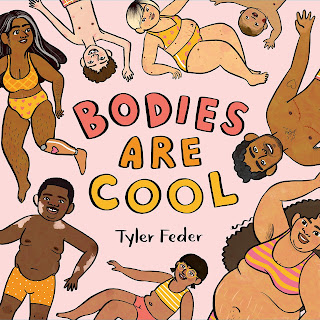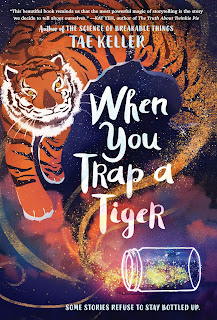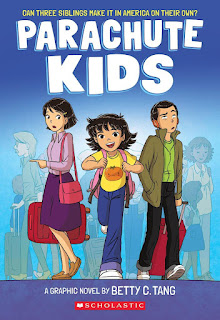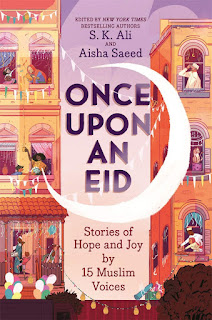MMGM and #IMWAYR: The Tea Dragon Society, Crumbs, Dancing at the Pity Party, and more!
Why, hello, hello! I've successfully shared all 10 graphic novels I read on my recent trip (see here and here), so now it's time to catch you up on what I've read since my return. Which isn't much—there was about a week in there where I didn't touch a book at all—but I'm hopefully getting back into a reading rhythm.
I've got four warm, inclusive, and thoughtful stories to share with you today, so no more dillydallying—let's get right to it!
Picture Books:
Bodies Are Cool
I read this because I adored Tyler Feder's graphic memoir, Dancing at the Pity Party, reviewed below, and I'm so glad to have consumed both her solo published works in a two-day span!
This is going to become so many kids' favorite book, (a) because the pages are so full of delightful scenery and action and detail to pore over, (b) because kids intuitively know that bodies are cool and this book affirms that, and (c) because the narration bounces along with repetition and ends every page with the same phrase that kids will love shouting out over and over again, "Bodies are cool!"
Bodies Are Cool is a tale of body positivity but also an ode to diversity in general. I feel confident saying that pretty much any kind of human, with any kind of physical or identity-related traits, will have an analogue within these pages. So kids will see themselves and basically every other human under the sun within this story!
I don't think I have much else to say, except that this is a delightful addition to the kids' books canon.
Middle Grade:
The Tea Dragon Society
(This story is a little below the MG age range, so younger readers can enjoy it too, although do see my comments in the second-to-last paragraph about that.)
After reading The Moth Keeper and now this book, I can safely say that I am a massive K. O'Neill fan—and luckily for me, they have plenty of other graphic novels (including two sequels in the Tea Dragon series) that I will now have to track down!
Just like The Moth Keeper, this book exudes love, warmth, trust, and compassion in a way few books ever do. O'Neill never lets a single touch of cynicism into their stories, but they hardly adhere to toxic positivity either—their characters thoughtfully navigate hardships and find hope through their connection to one another. There are parallels between the budding relationship of protagonist Greta and young Minette, and the longtime love between tea dragon caretakers Hesekiel and Erik, and you will easily fall in love with these characters through both their memories and newfound adventures.
The worldbuilding in The Tea Dragon Society is gentle yet rich—a delightful "handbook" for caring for tea dragons (part of the hardcover back matter) shares the full breadth of details about this fascinating fantastical species, while the story itself prefers to share details more gradually and naturally about the tea dragon's persnickety personalities and memory-infused tea leaves. I must say, the tea dragons are as adorable (especially when they're hanging out together) as the protagonists of the book, and I look forward to seeing more of them in the sequels.
Unlike The Moth Keeper, this particular story is light on conflict, and I want to hand this book to every single person who thinks you need conflict to make an interesting story—because you don't. What you actually need is depth, and this story is more than able to bring that in a tale that is ultimately gentle with its readers. The Tea Dragon Society becomes an eye-opening meditation on how traditions, memories, and even objects are the threads and throughlines of our lives—I definitely had a "Whoa" moment reading the conclusion Greta comes to at the very end.
O'Neill's art style is different here than in The Moth Keeper—while the colors are just as vivid and the characters just as adorable, the style is less textured and the characters don't have black borders around them. While I prefer The Moth Keeper's straight-off-a-tapestry look, there's no denying that the art in The Tea Dragon Society is as radiant and beautiful as art in kidlit comes. And O'Neill is skillful at conveying story information visually so the dialogue has room to breathe.
And one last wonderful thing is how much diversity this story packs in—characters of different races, LGBTQ+ identities, and abilities are omnipresent, ensuring that any reader will feel seen within these pages.
There was one line of dialogue that bugged me the slightest bit, and I was a touch frustrated that one flashback scene had blood in it, since I worry young readers who might otherwise love this story could be put off by that moment.
But those are deeply minor quibbles in this otherwise one-of-a-kind graphic novel. O'Neill deftly blends elements of fantasy, folktales, and children's stories to create a tale whose physical size (about that of a Little Golden Book) is as big as its heart and its wisdom. If you want to feel better—and really, who doesn't?—find this book, or really, any of O'Neill's works. You won't regret it.
Young Adult:
Crumbs
This is, no questions asked, one of the best (maybe the best) graphic novel romances I've ever had the luck to encounter. I can see why this book has practically expanded to fill the entire Barnes & Noble graphic novel section—we should all be shouting from the rooftops about its virtues!
Perhaps I've said this before, or absorbed it from some other blogger, but I feel like the typical YA romance formula involves a whole lot of build-up and will-they-won't-they energy, and then ends when the characters finally get together. But that formula completely skips over what it means to actually have a relationship—the joys, the challenges, and the shifts over time. That's why it's so refreshing that Crumbs doesn't follow this formula—it starts when Ray and Laurie's relationship begins, and it has plenty of Things to Say about the actual mechanics of love and relationships.
If I were to sort this book's themes into a big, broad category, that category would be how to balance being an individual, with your own hopes and dreams and private thoughts, and being one-half of something bigger with your romantic partner. Crumbs breaks this big category down into a series of really deep questions, like: How do you choose between personal goals and relationship goals, when both are meaningful in different ways, and one might be necessary for the other to thrive? Or, how do you decide when to keep something private from your partner (which is completely your right), and when to share vulnerably with them (which helps strengthen the bond you share)? (Crumbs puts a supernatural tinge on that last question.) Or even, what do you do to rebalance your own needs and the needs of others when that balance has been skewed for a while, and why might it have become skewed in the first place? These are all big questions, and creator Danie Stirling has clearly thought deeply about how they apply to Ray and Laurie, and in the process, how they might apply to us all.
So Crumbs is a brilliant meditation on the challenges of romance. It's also warm and sweet and full of delightful elements and trappings that make you basically want to pack your bags and move into the world of the story! First off, Ray and Laurie are precious—precious, I tell you. Ray is calm, thoughtful, and attentive—she moves through life as a quiet force. And Laurie radiates joy in a way that gives people around him space to come out of their shells, and rely on his supportive demeanor. The two of them make such a good couple, my goodness.
But that's not all—oh, no. Not only do we have fabulous protagonists, we also have delightful supportive characters, like bakery owner Marigold (Laurie's aunt) and Laurie's friends Molly, Sian, and Sebastian. We have fascinating yet easy-to-follow worldbuilding that meshes realistic and fantasy elements—Laurie's dream of becoming a musician stands in contrast to Ray's dream of using her Seer powers as a member of the Council, a mysterious but benevolent magic-infused government agency. There's a bakery like we have in the real world, but this one serves pastries that contain different emotions. There are cell phones, but these have personified and named digital assistants, crafted out of spells, that become almost pets and companions to their owners. One character is a werewolf—who also has to pick up odd jobs to pay the bills. It's a brilliantly crafted universe, and Stirling brings it to life with expressive, colorful art that is also impressively scenic—the backgrounds of each panel look as if someone brought a camera into the scene, and was just pointing it around at the room the characters are in. And one more perk—diversity in race, gender identity, and sexual orientation is abundant (as an example, Ray has been attracted to other girls in the past), so pretty much any reader will feel at home within this story.
This book was adapted from Stirling's online comic on Webtoon, and it absolutely deserves to exist as a (hefty!) physical book—I could hardly put this down over the two days I read it, and the only reason I didn't move faster was that I wanted to spend time with Ray and Laurie, in their world. Pursuing my passions and building a career are things I have to consider for my own horizon, and I've already been wondering how love might fit into that mix. And Crumbs is a blueprint I know I'll return to, both so I can learn from Ray and Laurie's experience of this balancing act, and so I can use my own experiences to best understand the lives of these one-of-a-kind characters.
Young Adult/Adult:
Dancing at the Pity Party
A Dead Mom Graphic Memoir
It was strange but also deeply comforting reading this book the day my grandfather passed away, and the day after. Two things I got out of the experience: (1) Tyler Feder is amazing and (2) they should just have a table at the funeral home covered in free copies of this book. Like, COVERED.
This book is obviously painful, but it's also laugh-out-loud funny and deeply sweet. And part of how it achieves the latter is that it is a beautiful ode to Feder's mother, Rhonda, who died when Feder was just nineteen. There's something so powerful to me about how the first chapter of this book brings knowledge of this wonderful human to so many people—and she so clearly deserves it. Was Rhonda a perfect human? No, as Feder acknowledges. But was she goofy and wildly competent and the rock of her family and generally amazing? Absolutely. Feder picks the perfect details to bring her mother to life in shockingly few pages—it's just wonderful.
Things obviously get less upbeat after chapter one, but I'm both grateful and amazed about Feder's honesty in recalling and portraying the whole experience of her mother's death. We see Feder's experience watching her mother's decline, then being there for her death, then grieving in the moment and afterward and even further after that and then now. There's really complicated emotions that she vulnerably shares in this memoir—one that felt so real was her acknowledgement that, after her mom's death, at least there wouldn't be any more phone calls and surprises about her continuing decline. That part, at least, was done.
Also, Tyler Feder has the most incredible sense of humor—which I sense that she got from her mom—and she uses humor to make this story so warm and welcoming and relatable, even amidst the most painful of times. I love the silly yet too-real pages she begins and ends chapters with—the flowchart of deciding whether or not to answer the phone, the selection of poses for "misery yoga," and the selection of supplies for the perfect crying session are just three examples of these frame-worthy interstitials. And her creativity and imagination extends beyond these standalone moments into the broader plot—the end of the story involves her heartwarming vision of what a physical meeting space for the Dead Moms Club would look like, and now I feel like we need to start a GoFundMe and build it ourselves.
Lastly, I'll say briefly Feder's art and writing are so compassionate and emotional and inviting and insightful—the craft in this book is truly mind-blowing, and part of me wants to stare at it all day and comb through every page.
There are books you just fall in love with instantly, and Dancing at the Pity Party is one. I cannot imagine the strength it took Tyler Feder to write this book, but I know so many people will be better off for it. There may not be a physical meeting space for the Dead Moms Club, but I feel like this book is a meeting space for the souls of club members, and really, of any human who's ever dealt with pain (so all humans). This is a book you can enter when you need to process, and breathe, and recover—it is safe and warm and gentle, like a bedroom or a blanket, or even a mom.







It looks like you've been reading a lot even with watching TV. I love reading but I also like to watch TV series I follow. The Tea Dragon Society sounds interesting. I'm curious about the tea dragons.
ReplyDeleteLike Natalie, I'd like to know more about the tea dragons, too, but you've also made me want to read each one, Max. Your reviews certainly bring joy for every book you share! I've bookmarked each one, will see what I can find from my library! Have a great week ahead!
ReplyDeleteI think when it comes to attitudes about death and positivity, there's a HUGE generational difference in how people deal with things. As a boomer, I didn't want anyone at work to know my father had died last year, because then they would just... look sad. Be sorry. I try to remember that my students don't have the same opinions as I do, but sometimes it is hard. Glad that you found some good in everything you read.
ReplyDeleteBodies Are Cool is a really cool book. An important one, too. This isn't a bad amount of reading at all! The cartoons sound interesting!
ReplyDeleteThese all sound great, and I appreciate your thoughtful reviews, as always. Dancing at the Pity Party is particularly intriguing to me. I was 50 when I lost my dad but can definitely still relate - the phrase "the sting of having the "I've got to tell Mom about this" instinct" is very familiar to me! I'm going to look for that one! And so glad you've found some TV shows that delight you!
ReplyDeleteSue
Book By Book
I like that The Tea Dragon Society isn't dependent on conflict. So often I've been told "No Conflict= No Story." I'm also a big fan of dragon stories so I will for sure be tracking this one down after reading your compelling review. Thanks for being a part of MMGM this week!
ReplyDeleteWell, you have sold me on all of these. Great reviews! I need to get them all and read them. Soon. Thank you for sharing them ❤️
ReplyDeleteHappy reading this week!
I read The Tea Dragon Society a few years ago and thought it was wonderful. I also like the look of Bodies Are Cool.
ReplyDeleteDancing at the Pity Party sounds like a terrific read. The others also look good, but that one sounds special. Thanks for sharing your thoughts on all these books.
ReplyDeleteI'm excited to have Tyler Feder read at our bookstore next month!
ReplyDeleteAnother great selection of graphic novels! The Tea Dragon Society is such a good title for a book! Dancing at the Pity Party sounds really good! Thanks for sharing!
ReplyDelete